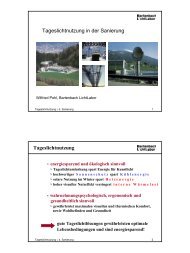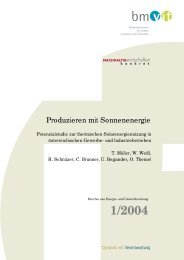Solar-supported heating networks in multi-storey residential buildings
Solar-supported heating networks in multi-storey residential buildings
Solar-supported heating networks in multi-storey residential buildings
You also want an ePaper? Increase the reach of your titles
YUMPU automatically turns print PDFs into web optimized ePapers that Google loves.
Architecture and aesthetics<br />
Until recently, the topic of solar energy systems was primarily addressed by energy eng<strong>in</strong>eers, who<br />
did not always manage to make people sufficiently aware of the many ways systems could be<br />
<strong>in</strong>tegrated <strong>in</strong>to build<strong>in</strong>gs. A glance at the technological development of solar energy systems over the<br />
past few years shows, however, that the most <strong>in</strong>novative developments occurred <strong>in</strong> the field of<br />
structural <strong>in</strong>tegration. The structural <strong>in</strong>tegration of solar energy systems now covers a broad spectrum<br />
of possibilities that can range from completely unnoticeable <strong>in</strong>stallations to elements that contribute to<br />
the build<strong>in</strong>g’s overall design. Assimilation with the build<strong>in</strong>g’s envelope (roof and facade <strong>in</strong>tegration),<br />
flexible build<strong>in</strong>g designs, prefabricated unit construction and flexible colour scheme are a few<br />
examples of what is understood by the term structural <strong>in</strong>tegration today.<br />
Energy efficiency<br />
<strong>Solar</strong> energy systems generate heat and should therefore be constructed <strong>in</strong> such a way that they can<br />
operate at top performance. This should also apply to structural <strong>in</strong>tegration (<strong>in</strong>cl<strong>in</strong>ation, direction and<br />
shade-coverage of the collectors). Numerous studies over the past several years have shown that<br />
tolerances <strong>in</strong> the case of deviations from the energetic optimum frequently result <strong>in</strong> only m<strong>in</strong>or<br />
reductions <strong>in</strong> output and therefore do not pose a risk to profitable operation. To ensure that solar<br />
energy systems can be <strong>in</strong>troduced on a broad front, energy eng<strong>in</strong>eers should take advantage of this<br />
considerable leeway and work together with the architects and clients to exploit the repertoire of<br />
modern structural <strong>in</strong>tegration.<br />
Economic efficiency<br />
To ensure that <strong>in</strong>vestment costs can be reduced by the maximum amount, all potential synergies have<br />
to be exploited. In the case of the <strong>in</strong>novative structural <strong>in</strong>tegration of collectors, this means that areas<br />
should be put to double use, for example by aim<strong>in</strong>g to achieve sav<strong>in</strong>gs <strong>in</strong> conventional surfaces,<br />
component layers, support<strong>in</strong>g structures, shad<strong>in</strong>g facilities etc. In addition, this could also reduce<br />
transmission heat losses and the amount of assembly work required.<br />
6.1<br />
Roof <strong>in</strong>tegration of solar collectors<br />
The most common form of structural <strong>in</strong>tegration for solar collectors is roof <strong>in</strong>tegration. It <strong>in</strong>volves<br />
mount<strong>in</strong>g the collector on top of the exist<strong>in</strong>g support<strong>in</strong>g structure so that the collector also provides<br />
protection from the elements. Assembly with the help of cranes is the standard method used for<br />
<strong>in</strong>dustrially manufactured large-area collectors (Figure 20). In some projects, prefabrication and cost<br />
reductions have already been made to the extent that roof<strong>in</strong>g elements assembled at the plant<br />
(consist<strong>in</strong>g of support<strong>in</strong>g structures, heat <strong>in</strong>sulation and collector) only have to be moved to their<br />
proper location at the construction site (Figure 21). The hydraulic connection of the <strong>in</strong>dividual largearea<br />
collectors and the <strong>in</strong>stallation of the ma<strong>in</strong> l<strong>in</strong>es are carried out <strong>in</strong> the attic, which is protected<br />
aga<strong>in</strong>st the weather.<br />
29














